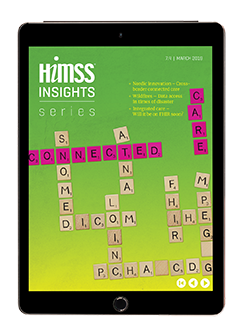
On a healthcare system level, digitization promises to help tear down the walls between different care silos. In many countries, this is still quite a challenge, both for political and technical reasons. This issue of HIMSS Insights eBook highlights healthcare systems that take connected care seriously and discuss the lessons to be learned from these leaders of change. We will also find out which technical standards are experiencing a tail wind, and how that is helping healthcare digitization to keep its promises.
In early 2019, the U.S. government hinted that it was willing to increase the pressure on medical institutions and healthcare IT providers that don’t show sufficient engagement in making patient data available. There was also a strong commitment toward using FHIR for APIs as the industry moves in the direction of healthcare digitization.
Meanwhile, in Europe, the European Commission issued the first version of its recommendations for an electronic patient record exchange format, well received by the standardization communities and by many industry representatives. They are full of HL7 and CDA, and towards the end, they touch on HL7 FHIR too.
This is good news. There are still some people who try to tell us that proper standards for digitally connected care are, if anything, emerging and that it makes sense to wait for them to mature. The reality is: The puzzle pieces have long started to fall into place. Countries and companies that ignore them will be left behind or are already being so.
We are presenting a couple of very convincing examples for making connected care a reality by using international standards in this issue of HIMSS Insights. We also take a close look at a standard that can justifiably be called ‘still emerging.’ In fact it’s brand new, and it addresses the question of how to get ‘omics’ data into the connected care game. Exciting, especially since it shows how stimulating it can be to let people from outside of healthcare into the arena.
